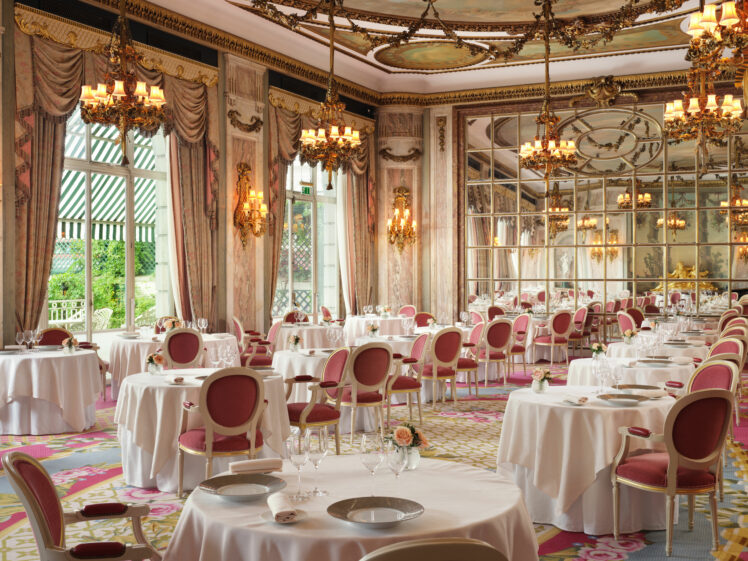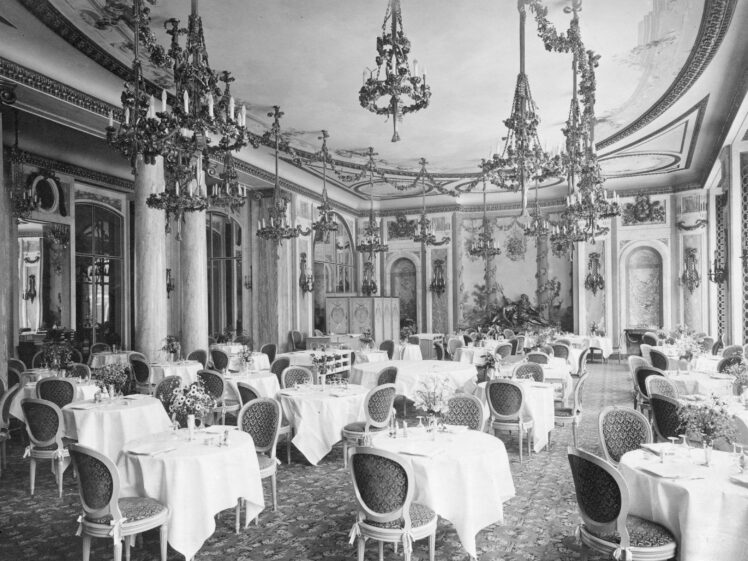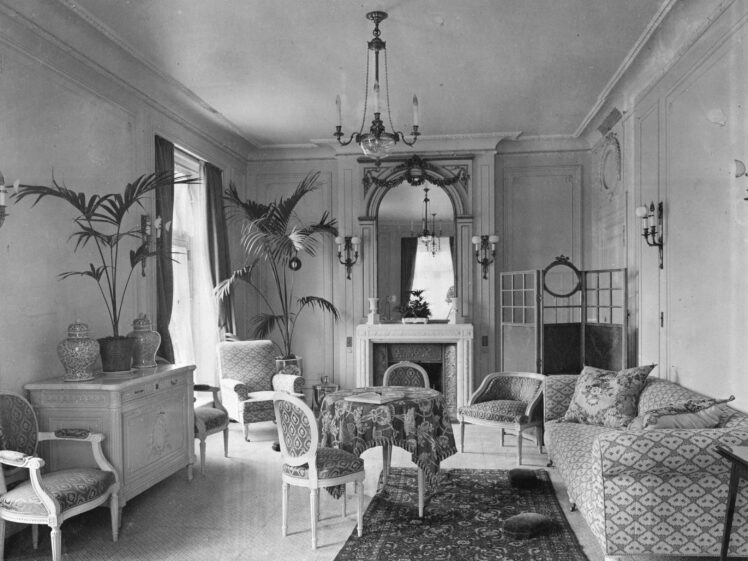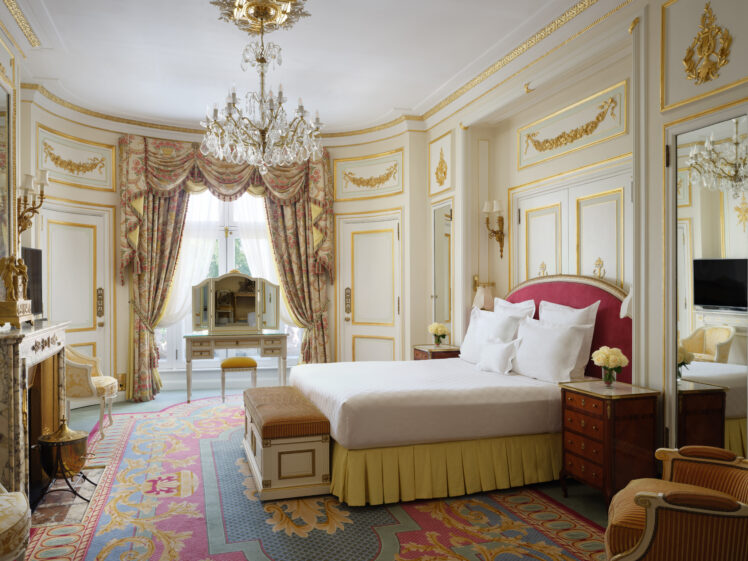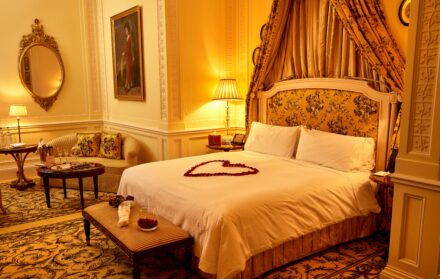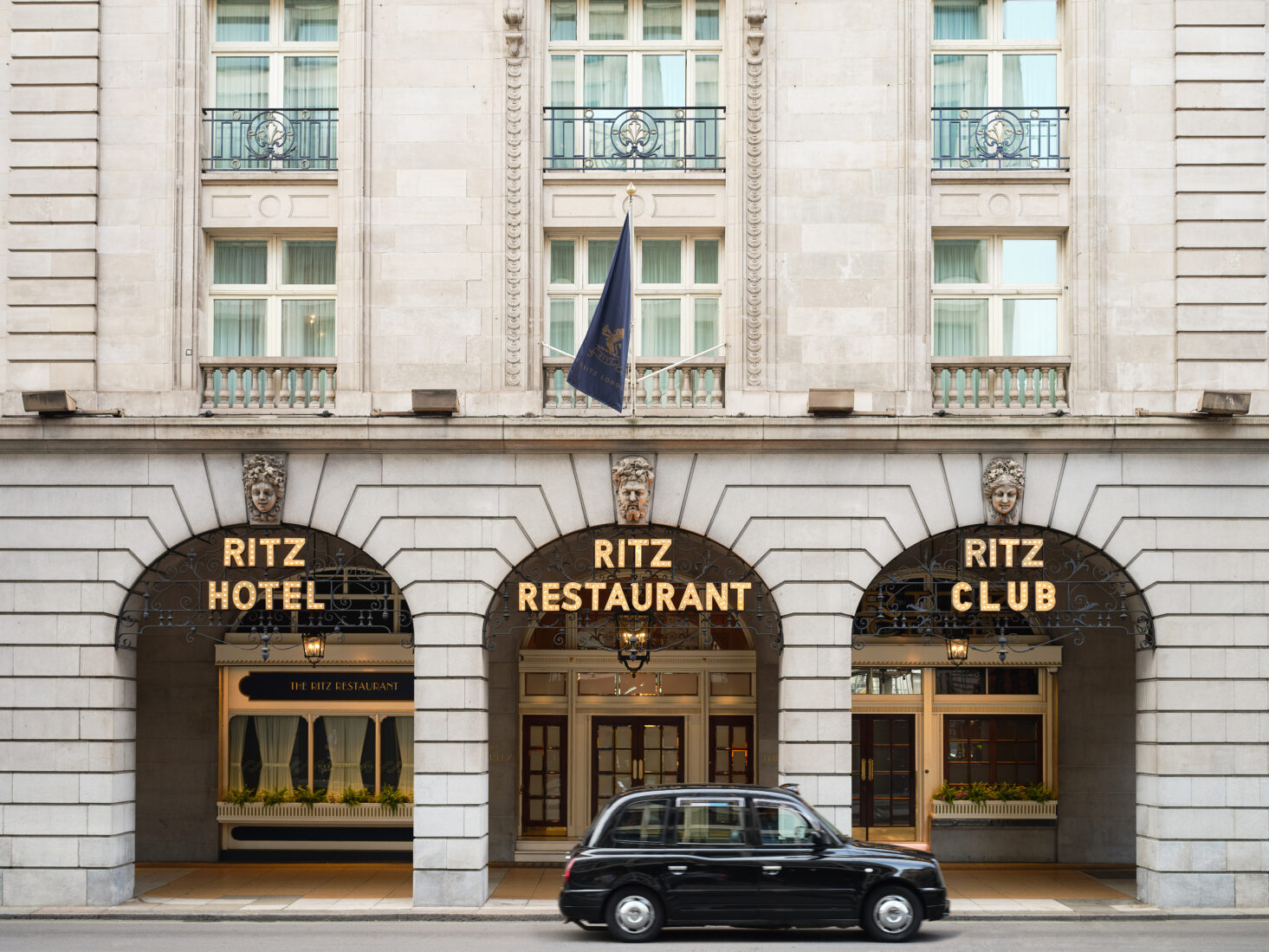
The Ritz London: A brief history of the capital’s most famous hotel
We go inside London’s most historic hotel to discover not only its unrivalled guestbook, but a storied past that dates back to 1906
So many of the globe’s great and good have graced The Ritz. It’s not only a London institution, but a shining, glitzy beacon of hospitality that radiates across the world. And while its legacy knows no bounds, much of the hotel’s history has been kept under wraps – not a secret per se, but just reserved for those in the know.
One man who is certainly in the know is head concierge, Michael De Cozar. We meet in one of The Ritz’s signature suites; decked out in the hotel’s classic red furnishings, golden details and sweeping views across Piccadilly and Green Park. He is evidently proud of his career – “If I had my life again, I would do the same thing. I hope The Ritz tradition lives on forever and ever” – and oozes charm, which has earned him roles in 1993’s Notting Hill (look closely and you’ll spot him in the famous Horse & Hound scene) and 2019 docuseries Inside The Ritz.
Having joined The Ritz in 1973 at the tender age of 16 – following in his father’s footsteps who worked as a concierge before him, and with his son Robert now also part of the front-of-house team – De Cozar recalls unique interactions with the likes of the Queen Mother, Princess Diana, Jackie Onassis and Margaret Thatcher. While the mid-late 20th century was when The Ritz concreted its position as a world-class hotel (it was only in March 1965, when it was officially listed in the famous Buildings of England series, that the looming threat of demolition was removed) to understand the roots of the hotel is to imagine what it was like when The Ritz opened its doors on 25 May 1906.
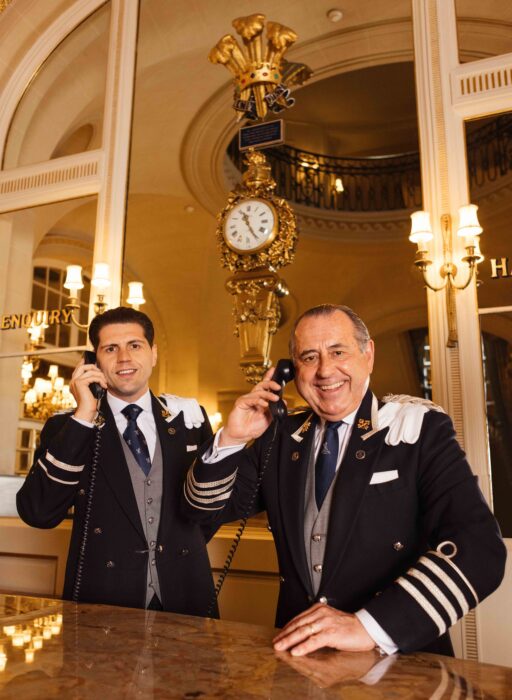
Michael De Cozar with his son Robert
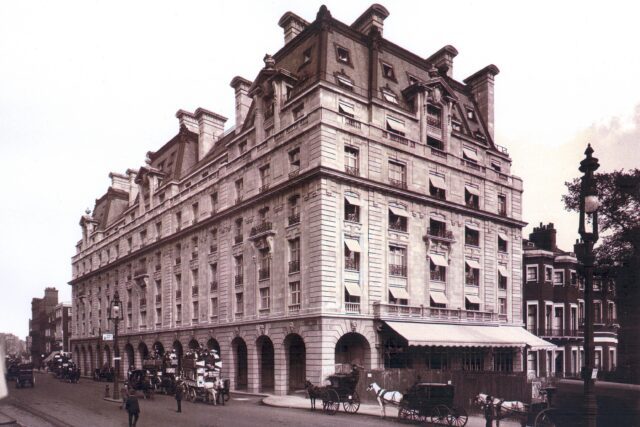
The Ritz Hotel in 1906
“Classy, glamorous and expensive,” says De Cozar, in his Cockney-Spanish lilt. “It was the place to be and, because César Ritz opened it, the story goes he tried to rectify all the mistakes he made in Paris.” The unique metal structure was constructed for the Swiss hotelier by the same architects who conceived his French hotel of the same name eight years earlier – Charles Mewès and Arthur Davis – and from the beginning, the hotel was enchanting, with the press calling it a ‘Palace of White’ (London Evening News, now the London Evening Standard) and a ‘Fairy Palace’ (Staffordshire Sentinel). As an eloquent missive from a member of Edwardian high society, sourced by historian Tamsin Everenden, said: “London has always seemed to me the centre of the world […] and I have always regarded The Ritz as the centre of London.”
Inside the hotel, much of its original decor and interiors are remarkably well preserved. The foyer provides a gateway into the rest of the establishment, and plays a key role in The Ritz’s history, with the distinctive mirrored wall behind the concierge (whose uniforms have changed little, and longevity goes deeper than that) extending down the Long Gallery to The Ritz Restaurant – formerly known as the Louis XVI – and passing a series of historic entertaining spaces.
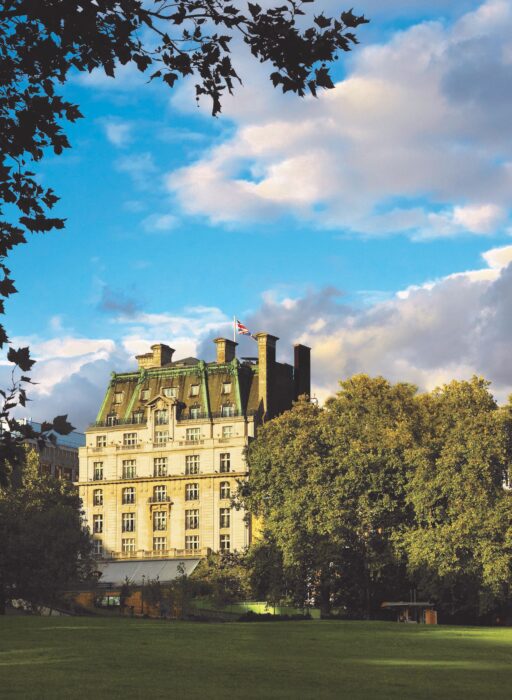
The Ritz from Green Park
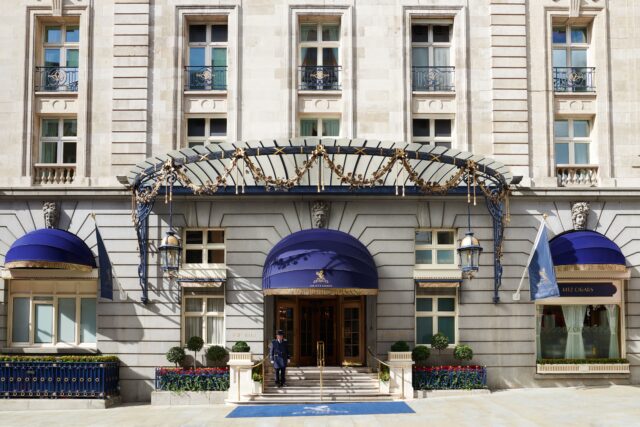
Off to the right is the Rivoli bar, then you come to the Palm Court on the left, opposite the original Piccadilly entrance, before approaching the Marie Antoinette suite to the right. “The Marie Antoinette suite is a replica of the Palace of Versailles,” explains De Cozar. “The Palm Court (for afternoon tea) is now an institution where we do five sittings a day. But in those days, it was a lounge where people lingered with a glass of champagne and were very elegantly dressed. We used to have to hire doormen here that were 6ft plus to reach the horses and carriages that arrived.”
These larger areas are interspersed with intimate alcove-style spaces with chairs and tables; César Ritz did not like closed areas and preferred to have those seated able to view the traffic of clients moving toward the restaurant, giving the whole Long Gallery the function of a starry boulevard.
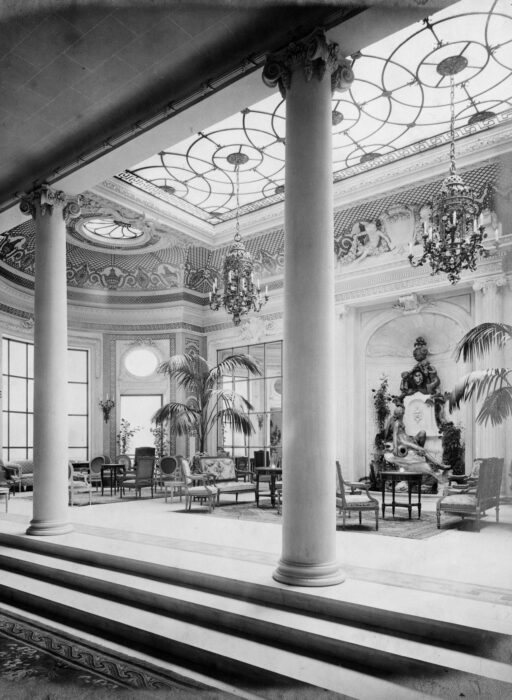
The Palm Court in 1906
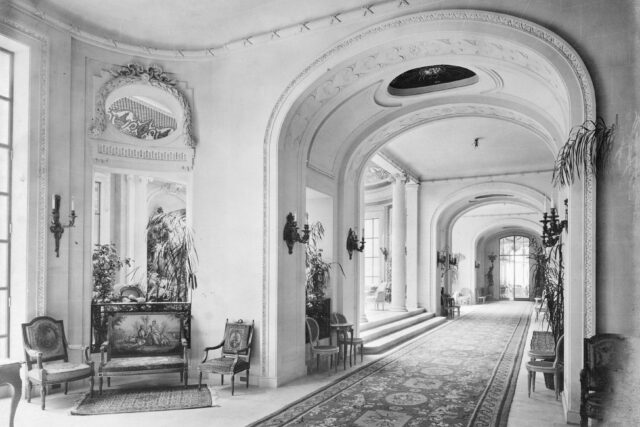
The Long Gallery in 1906
The constant effect of warm light and gold is also intentional, and part of the César Ritz’s legacy. When it opened, The Ritz famously painted its lampshades pink on the inside in order to emit a flattering glow and the gold-leaf gilding of the interior was part of the original scheme. Nowhere else in London, at the time, offered quite such a combination of exclusive intimacy and palatial opulence.
“Clients came from all over the world to stay at The Ritz because of the service, food and the ambience,” says De Cozar. “The [tips were so big that the] cloakroom attendants and the doorman used to pay the hotel to work here. I remember during my early days helping the cloakroom when we had functions, the quality of the clientele was fantastic and our dress codes have never changed.” No surprise then that, on being asked by the then-housekeeper if all was well, Jackie Onassis replied: “It’s like paradise.”
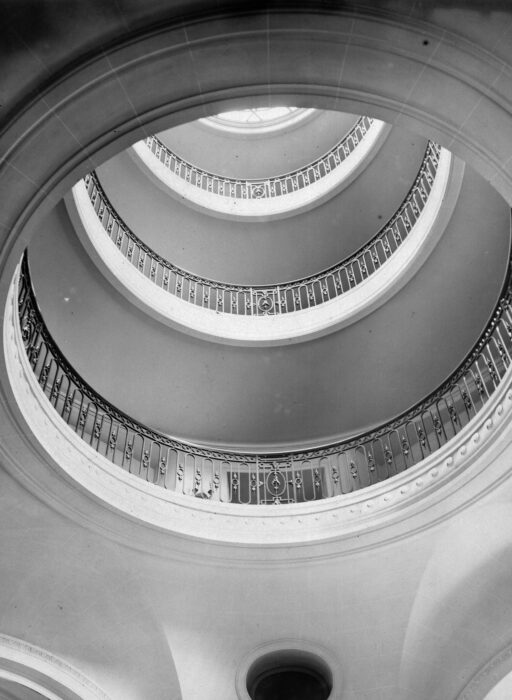
The Ritz Lobby in 1906
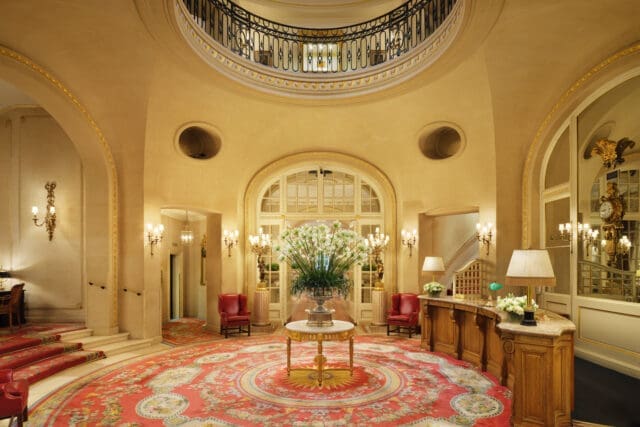
The Ritz Lobby
From the outset, a visit to The Ritz was always deemed a treat, but César Ritz’s encouragement for female guests to dine and meet on their own by bringing in popular entertainers was atypical of the Edwardian period. “[He] would hire Johann Strauss to play – but he never made any money because he came at a cost,” explains De Cozar. “So when he was asked how he could afford [him], he would ask the sommelier how many extra wine bottles were sold on that day – and that was the answer. He liked to do everything theatrically.
“The management [today] has the César Ritz mentality. When he built it, he knew he wanted the very best – he found the best location and then searched for the best staff, from hotel managers to chefs. This is the difference from other hotels: discretion, look the part, approachable, good eye contact, smiling and making sure everything you do for the guest makes their life easier. We love a challenge – the bigger the better. We make it happen at whatever time of the day.”
So much so that De Cozar himself has dealt with many guests’ requests. “As a young page boy, I remember Jackie Onassis. Her daughter Caroline [Kennedy] was at a Harley Street clinic getting her tonsils out. I was asked to see her, write down what [products] she wanted, go to Fortnum and Mason and then I delivered them to Caroline,” he explains. “I have had a lot of dealings since with Mrs Onassis [and] also helped her son, John Kennedy. Once when he came here, he was beaten up very badly and I assisted him with doctors in a room in the hotel.”
De Cozar says Jackie Onassis is one of four leading ladies in his life. “The Queen Mother – she was very gracious and only lived down in Clarence House so would sometimes walk here. The Ritz was her favourite place. She would walk in, everybody would stand up and she would make her way through to the restaurant. Her security officers told me the only thing she hates about The Ritz is that the chairs are high and she’s quite small, and when she’s at the palace she has a foot stool. So I asked our carpenter to make a footstool and I presented that to the Queen Mother when she next came to The Ritz.”
The third is Princess Diana, who visited often. “The next one is Margaret Thatcher. During the last three months of her life, she spent time at The Ritz. We were invited to the funeral at St Paul’s Cathedral and then the Guildhall afterwards. She was here often: before she was a prime minister with her family, through her time as prime minister and afterwards, when she would come in for lunch with friends.”
What tends to be less subject to public record, however, is the hotel's history as a backdrop to diplomatic functions as well as glamorous press nights. Not only have stars such as Charlie Chaplin and Marilyn Monroe crossed the foyer, but Mahatma Gandhi hosted The Aga Khan here in September 1931, for a ‘Midnight Talk at Ritz Hotel’ event during the Round Table Conferences. Churchill also famously hosted a meeting with French President Charles de Gaulle and American President Dwight Eisenhower in the Marie Antoinette suite in 1942.
But one of The Ritz’s most starry and celebrated connections is to the British Royal Family. As the recent series of Netflix’s The Crown dramatised, it was to The Ritz that the young Queen Elizabeth and her sister Princess Margaret escaped to celebrate VE day, and the hotel is justly proud of its royal warrant today. “Queen Elizabeth had so many experiences here and held her 80th birthday here,” explains De Cozar. “The whole of the downstairs floor was given to her by the owners.
“Paul Thomas, who created her flowers, arranged our Christmas tree and one of the last times she came in was to view it. She loved The Ritz because we were her neighbours. She came behind the desk and said to me, 'It must be wonderful to work here'. Discretion is the word at The Ritz – and that’s why [the Royal Family and celebrities] come back.”
Visit theritzlondon.com
Read more: Grand Hotel Tremezzo: An Art Nouveau gem on the shores of Lake Como
